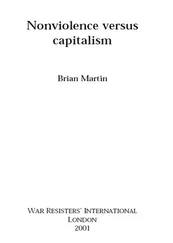Thus, most of the ten criteria for AT are also suitable for selecting technology for nonviolent struggle and none is incompatible with requirements for nonviolent struggle. This suggests a high degree of overlap between these two ways of approaching technological choice. There are a few differences, though. The ten criteria are mainly aimed at poor countries. In rich countries, there are some technologies that do not fit AT criteria but may still be highly useful for nonviolent struggle. For example, a sophisticated system of telecommunications will aid nonviolent struggle, especially if designed so that it cannot be readily controlled or monitored centrally. There are enough technically trained people in rich countries to allow for some degree of community control of telecommunications, though in practice many changes would be necessary to bring this about.
When it comes to the major systems necessary for survival — agriculture, energy, manufacturing, transport — rich countries mostly have been moving away from criteria for AT and instead becoming more vulnerable to disruption and takeover. The AT movement provides a direction for change, and many individuals and groups have made valiant efforts to move in this direction, but they have not been very successful in the face of dominant forces, including the military — military technology is seldom AT.
The connection between AT and technology for nonviolent struggle almost seems too easy. If AT advocates had been more successful over the years, then technological systems would be set up for effective nonviolent resistance. Why should the convergence be so neat? To begin, further study is needed to determine whether the connection is really as straightforward as it seems from a preliminary analysis. But there are some general reasons for the convergence. AT can be considered to be the technological component of a general strategy of community self-reliance, which can be treated as a strategy for development. [20] . Johan Galtung, Peter O’Brien and Roy Preiswerk (eds.), Self-Reliance: A Strategy for Development (London: Bogle-L’Ouverture, 1980).
The strategy of self-reliance challenges the usual approach of development from above, which typically involves centralised governments (often dominated by the military) and harsh economic control by international agencies, all of which make local populations subject to both repression and international economic exploitation. Self-reliance is thus a strategy that aims at liberation from both repression and oppression. In as much as AT fits into this strategy, it provides support for nonviolent struggle against repression and oppression. Of course, AT won’t provide everything useful for nonviolent struggle, but it’s a good place to begin.
In poor countries, most people have traditionally lived on the land. With their integration into the world economy, there have been strong pressures to produce cash crops for export. No longer being self-sufficient in food, this makes the people more vulnerable to local dictators as well as foreign aggressors. This form of “development” thus works hand-in-hand with military systems. In this context, land reform becomes a measure to foster the capacity for nonviolent struggle. The technology of local food production is one aspect of this issue, but the key is self-reliance and local control.
by Helen Gillett, Brian Martin and Chris Rust
Architecture and town planning have a big impact on the willingness and capacity of people to engage in nonviolent struggle. [1] . This chapter is adapted from Helen Gillett, Brian Martin and Chris Rust, “Building in nonviolence: nonviolent struggle and the built environment,” Civilian-Based Defense, Vol. 11, No. 3, Fall 1996, pp. 1, 4-7, which also describes military influences on the built environment.
By the design of workplaces, people may find it easy to get together to talk or they may find it easier to remain separate. For example, if there is an attractive and convenient place to eat lunch, workers are more likely to get together then; if not, they are more likely to eat separately. Similarly, the design of housing and layout of streets have a big impact on communication patterns, such as whether people speak to their neighbours or visit other people’s homes.
Cultural traditions play a big role in social behaviour, but town planning and architecture are quite influential. In high-rise blocks of apartments, without convenient communal facilities, there is little sense of community. In typical US suburbs, the dispersed physical layout encourages families to mostly interact with themselves and perhaps a few neighbours. In the Israeli kibbutzim, by contrast, the buildings are originally designed to foster high social interaction, for example in the communal child rearing. At intermediate possibility is “co-housing,” found for example in Denmark, which combines private living quarters with some collective facilities such a dining hall. [2] . Kathryn McCamant, Cohousing: A Contemporary Approach to Housing Ourselves (Berkeley, CA: Habitat Press, 1988).
Transport systems have an important impact on the capacity for nonviolent struggle through their effect on community solidarity. The automobile is a major problem in this regard, since a dispersed, car-dependent society tends to separate people from each other, putting them in suburbs remote from work, shops and leisure. Freeways are notorious for breaking up communities. Automobility for those with access to cars reduces mobility for those without, causing social inequality and reducing social solidarity. The transport modes most likely to foster a sense of community are those which cater for everyone, including children, the poor and people with disabilities. This means walking and low-priced public transport. [3] . Donald Appleyard, Livable Streets (Berkeley: University of California Press, 1981); Ivan Illich, Energy and Equity (London: Calder and Boyars, 1974); K. H. Schaeffer and Elliot Sclar, Access for All: Transportation and Urban Growth (Hasmondsworth: Penguin, 1975).
In facilitating nonviolent resistance it is desirable that members of a community interact and communicate with each other in a manner that produces a “sense of community” which also facilitates organisation of their defence. One way in which the built environment is likely to aid this is through the provision of “meeting places.” A number of public arenas can be meeting places, including footpaths and pavement cafes, market squares, shopping malls, community centres and town halls, fair and sporting grounds, gardens, parks (especially those containing water sites), playgrounds, and commons. Though many cities incorporate such places in their layout, the number, location, design, and style of public spaces influence community solidarity.
To achieve this, meeting places should be abundant enough to be easily accessible by members of the community, preferably within a short walk by local residents. The provision of meeting places in this way could make high density housing much more enticing. Suburban housing blocks tend to emphasise individuals more than communities. Where space considerations limit housing to high rise apartment buildings, meeting places (similar to office tea or staff common rooms) could also be contained near, and open to, the stairwell of each building floor or level.
A preference for higher density housing is echoed by Edmund Fowler when he discusses deconcentrated housing. Higher density housing environments foster neighbour interaction, which can cause tensions and culture clashes, but also can be valuable toward solving social problems. In contrast, physically segregated communities lead to diminished social and political skills and responses, and hence reduced civic participation. Contact between people is greater with mixed land use and building age, and short blocks with concentration of use. Under such combination of private and public life, residents tend toward “looking after their street,” and developing networks of trust and confidence. These conditions deter vandalism and similar problems. Unfortunately contemporary urban environments are “justified” by supposedly “objective” economic indicators, such as household incomes and the number of owner-occupied houses, though, Fowler argues, servicing and supplying deconcentrated housing costs more. [4] . Edmund P. Fowler, Building Cities that Work (Montreal: McGill/Queen’s University Press, 1992). Fowler discusses a number of issues along these lines; see also Jane Jacobs, The Death and Life of Great American Cities (New York: The Modern Library, 1969).
Читать дальше












